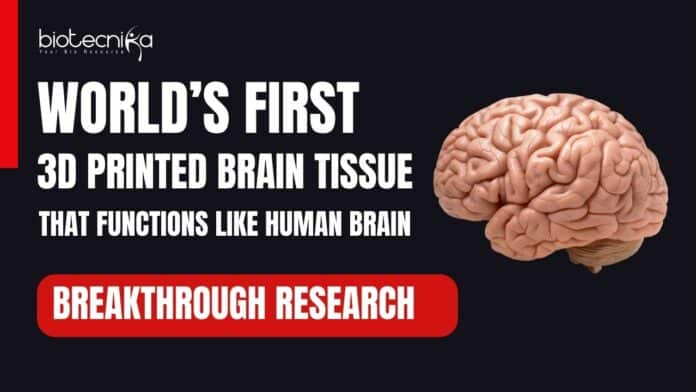World’s First 3D Printed Brain Tissue – Scientists Make Breakthrough in Brain Tissue Research with 3D Printing Technology
In a remarkable scientific feat, researchers have successfully developed the world’s first 3D-printed brain tissue that exhibits similar behavior to natural brain tissue. This groundbreaking achievement is set to revolutionize the field of neurology and neurodevelopmental disorders by providing advanced solutions for conditions such as Alzheimer’s and Parkinson’s disease.
Understanding Brain Communication
The development of functional 3D-printed brain tissue opens up doors for scientists to gain a deeper understanding of how brain cells and different regions of the brain communicate with each other. Professor Su-Chun Zhang, a renowned neuroscience and neurology expert at UW-Madison’s Waisman Center, highlights the significance of this development, stating that it has the potential to transform stem cell biology, neuroscience, and the study of various neurological and psychiatric disorders.
Innovative Approach for Printing Brain Tissue
Scientists adopted a novel approach by using a 3D printer that stacked layers horizontally, diverging from the traditional method of printing vertically. Additionally, brain cells known as neurons were cultivated from induced pluripotent stem cells and placed in a specialized “bio-ink” gel that had a softer consistency than previous attempts. This new gel
provided an optimal environment for the neurons to grow and establish connections with each other.Promising Results
The 3D-printed brain tissue exhibited remarkable attributes similar to those found in natural brain tissue. The neurons were capable of communicating with each other, sending signals and interacting through neurotransmitters. Interestingly, even when different types of cells from distinct brain regions were printed, they still maintained the ability to communicate in a specific and unique manner.
Advantages Over Other Techniques
Experts believe that this 3D printing technique offers superior precision compared to alternative methods, such as brain organoids. Brain organoids are miniature replicas of organs, frequently employed in neuroscience research. This new technique allows scientists greater control over the cell types and arrangements within the printed tissue, enabling them to study the brain’s intricate structure with unprecedented flexibility.
Future Implications
The development of functional 3D-printed brain tissue opens up a wealth of possibilities for neuroscience research and could potentially lead to groundbreaking advancements in the diagnosis and treatment of neurological and neurodevelopmental disorders. Furthermore, the ability to recreate specific parts of the brain using 3D printing technology may provide crucial insights into the functioning of different brain regions and their role in cognitive processes.
The achievement of printing functional brain tissue using 3D technology marks a significant milestone in the world of neuroscience. This breakthrough has the potential to reshape our understanding of brain function and pave the way for new treatments for various neurological and neurodevelopmental disorders. As researchers continue to explore the capabilities of 3D printing, the future looks promising for advancements in brain research and the improvement of patient care.
Keywords: 3D printing brain tissue, neurology breakthrough, neurodevelopmental disorders, Alzheimer’s disease, Parkinson’s disease, stem cell biology, neuroscience, psychiatric disorders, brain communication, 3D printer, brain organoids, precision, cognitive processes.






























